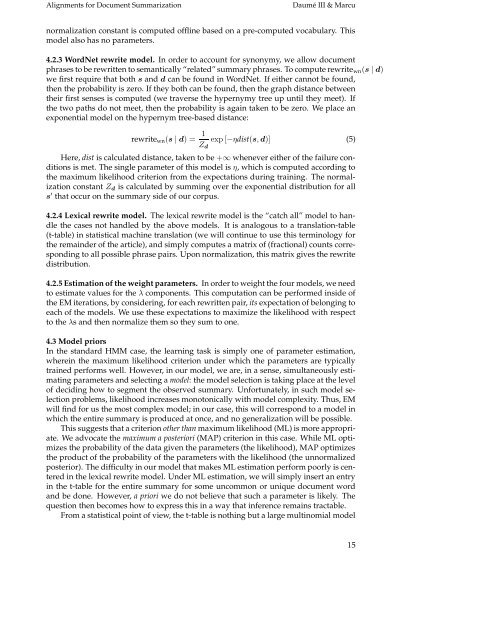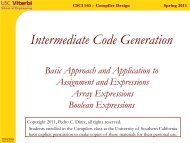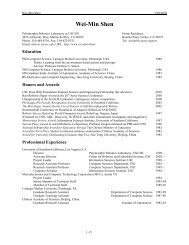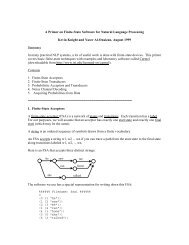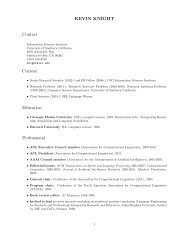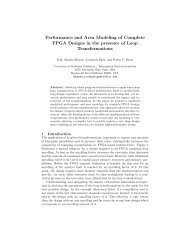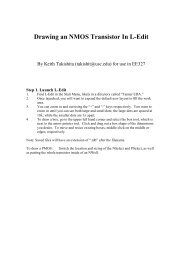Induction of Word and Phrase Alignments for Automatic Document ...
Induction of Word and Phrase Alignments for Automatic Document ...
Induction of Word and Phrase Alignments for Automatic Document ...
Create successful ePaper yourself
Turn your PDF publications into a flip-book with our unique Google optimized e-Paper software.
<strong>Alignments</strong> <strong>for</strong> <strong>Document</strong> Summarization Daumé III & Marcu<br />
normalization constant is computed <strong>of</strong>fline based on a pre-computed vocabulary. This<br />
model also has no parameters.<br />
4.2.3 <strong>Word</strong>Net rewrite model. In order to account <strong>for</strong> synonymy, we allow document<br />
phrases to be rewritten to semantically “related” summary phrases. To compute rewritewn(s | d)<br />
we first require that both s <strong>and</strong> d can be found in <strong>Word</strong>Net. If either cannot be found,<br />
then the probability is zero. If they both can be found, then the graph distance between<br />
their first senses is computed (we traverse the hypernymy tree up until they meet). If<br />
the two paths do not meet, then the probability is again taken to be zero. We place an<br />
exponential model on the hypernym tree-based distance:<br />
rewritewn(s | d) = 1<br />
Zd<br />
exp [−ηdist(s, d)] (5)<br />
Here, dist is calculated distance, taken to be +∞ whenever either <strong>of</strong> the failure conditions<br />
is met. The single parameter <strong>of</strong> this model is η, which is computed according to<br />
the maximum likelihood criterion from the expectations during training. The normalization<br />
constant Zd is calculated by summing over the exponential distribution <strong>for</strong> all<br />
s ′ that occur on the summary side <strong>of</strong> our corpus.<br />
4.2.4 Lexical rewrite model. The lexical rewrite model is the “catch all” model to h<strong>and</strong>le<br />
the cases not h<strong>and</strong>led by the above models. It is analogous to a translation-table<br />
(t-table) in statistical machine translation (we will continue to use this terminology <strong>for</strong><br />
the remainder <strong>of</strong> the article), <strong>and</strong> simply computes a matrix <strong>of</strong> (fractional) counts corresponding<br />
to all possible phrase pairs. Upon normalization, this matrix gives the rewrite<br />
distribution.<br />
4.2.5 Estimation <strong>of</strong> the weight parameters. In order to weight the four models, we need<br />
to estimate values <strong>for</strong> the λ components. This computation can be per<strong>for</strong>med inside <strong>of</strong><br />
the EM iterations, by considering, <strong>for</strong> each rewritten pair, its expectation <strong>of</strong> belonging to<br />
each <strong>of</strong> the models. We use these expectations to maximize the likelihood with respect<br />
to the λs <strong>and</strong> then normalize them so they sum to one.<br />
4.3 Model priors<br />
In the st<strong>and</strong>ard HMM case, the learning task is simply one <strong>of</strong> parameter estimation,<br />
wherein the maximum likelihood criterion under which the parameters are typically<br />
trained per<strong>for</strong>ms well. However, in our model, we are, in a sense, simultaneously estimating<br />
parameters <strong>and</strong> selecting a model: the model selection is taking place at the level<br />
<strong>of</strong> deciding how to segment the observed summary. Un<strong>for</strong>tunately, in such model selection<br />
problems, likelihood increases monotonically with model complexity. Thus, EM<br />
will find <strong>for</strong> us the most complex model; in our case, this will correspond to a model in<br />
which the entire summary is produced at once, <strong>and</strong> no generalization will be possible.<br />
This suggests that a criterion other than maximum likelihood (ML) is more appropriate.<br />
We advocate the maximum a posteriori (MAP) criterion in this case. While ML optimizes<br />
the probability <strong>of</strong> the data given the parameters (the likelihood), MAP optimizes<br />
the product <strong>of</strong> the probability <strong>of</strong> the parameters with the likelihood (the unnormalized<br />
posterior). The difficulty in our model that makes ML estimation per<strong>for</strong>m poorly is centered<br />
in the lexical rewrite model. Under ML estimation, we will simply insert an entry<br />
in the t-table <strong>for</strong> the entire summary <strong>for</strong> some uncommon or unique document word<br />
<strong>and</strong> be done. However, a priori we do not believe that such a parameter is likely. The<br />
question then becomes how to express this in a way that inference remains tractable.<br />
From a statistical point <strong>of</strong> view, the t-table is nothing but a large multinomial model<br />
15


